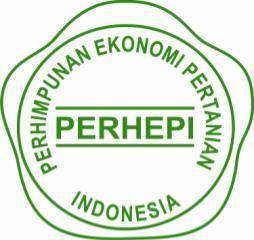ANALISIS USAHA DAN STRATEGI PENGEMBANGAN USAHA KECIL MENENGAH (UKM) GETHUK TAKE, TAWANGMANGU KARANGANYAR
Abstract
Keywords
Full Text:
PDFReferences
Alamanda, D. T., Anggadwita, G., Raynaldi, M., Novani, S., & Kijima, K. (2009). Designing strategies using IFE, EFE, IE, and QSPM analysis: digital village case. The Asian Journal of Technology Management (AJTM), 12(1), 48–57.
Blocher JE, Kung HC, Gary C, T. W. (2007). Manajemen Biaya Penekanan Strategis (Buku 1 Edisi 3). Jakarta: Salemba Empat.
BPOM, 2019. Badan POM Dukung Peningkatan Daya Saing UMKM Pangan. Retrieved from www.pom.go.id.
Budiarto R, Susetyo Hario Putero, Hempri Suyatna, Puji Astuti, Harwin Saptoadi, M. Munif Ridwan, B. S. D. (2015). Pengembangan UMKM Antara Konseptual dan Pengalaman Praktis. Yogyakarta: Gadjah Mada University Press.
College George Brown. (2014). Break Even Point Analysis. Educational Ressources Tutoring and Learning Centre, 2–4.
David ME, Forest RD, F. R. (2009). The quantitative strategic planning matrix (qspm) applied to a retail computer store. He Coastal Business Journal, 8(1), 42–52.
David dan Forest (2016). Manajemen Strategik Suatu Pendekatan Keunggulan Bersaing. Jakarta: Salemba Empat.
Evaliza, D., Putri, N. E., & Fauza, H. (2015). Lotanbar chili farming analysis in support of a new superior cultivar from the district of limapuluh kota. International Journal on Advanced Science, Engineering and Information Technology, 5(1), 40–43.
Fazlollahtabar, H. (2018). Supply Chain Management Models. Amerika Serikat: CRC Press.
Ghorbani, A., Raufirad, V., Rafiaani, P., & Azadi, H. (2015). Ecotourism sustainable development strategies using swot and qspm model: a case study of Kaji Namakzar Wetland, South Khorasan Province, Iran. Tourism Management Perspectives, 16(5583):290–297.
Gorener A, Toker, Kerem, Korkmaz, U. (2012). Application of Combined SWOT and AHP : A Case Study for a Manufacturing Firm. 58, 1525–1534.
Irianto, H., Mujiyo, M., Qonita, A., Sulistyo, A., & Riptanti, E. W. (2020). The Development of jarak towo cassava as a high economical raw material in sustainability-based food processing industry. AIMS Agriculture and Food, 6(1), 125–141.
Istianah N, Hilya F, E. S. (2019). Perancangan Pabrik untuk Industri Pangan. Malang: UB Press.
KemenkopUKM, 2018. Perkembangan data usaha mikro, kecil, menengah (UMKM) dan usaha besar (UB) tahun 2018-2019. Retrieved from www.kemenkopukm. go.id.
Liu, Y., & Tyagi, R. K. (2017). Outsourcing to convert fixed costs into variable costs: a competitive analysis. International Journal of Research in Marketing, 34(1), 252–264.
Minarni, Indra Warman, W. H. (2017). Case-Based reasoning (cbr) pada sistem pakar identifikasi hama dan penyakit tanaman singkong dalam usaha meningkatkan produktivitas tanaman pangan. TEKNOIF, 5(1), 41–47.
Niode, I. Y. (2009). Sektor UMKM di Indonesia: profil, masalah dan strategi pemberdayaan. Jurnal Kajian Ekonomi Dan Bisnis OIKOS-NOMOS, 2(1), 1–10.
Patoki, A. K., & Effendy. (2017). Analisis profitabilitas keripik singkong pada industri rumah tangga pasudan di kota palu. Agrotekbis, 5(1), 77–85.
Primyastanto, M. (2014). Aplikasi Teori Pemasaran pada Komoditi Perikanan dan Kelautan. Malang: UB Press.
Rauch P, UJ Wolfsmayr, SA Borz, M. T. (2015). SWOT analysis and strategy development for forest fuel supply chains in South East Europe. ELSEIVER, 61, 87–94.
Retnaningsih, N., & C, B. N. (2018). Strategi pengembangan jamur tiram (pleurotus ostreatus) di kelompok tani aneka jamur Desa Gondangmanis Kecamatan Karangpandan Kabupaten Karanganyar. SEPA: Jurnal Sosial Ekonomi Pertanian Dan Agribisnis, 14(1), 61-68.
Soekartawi. (2005). Agribisnis (Teori dan Aplikasinya). Jakarta: PT Raja Grafindo Persada.
Sulaiman & Natawidjaja, R. S. (2018). Analisis nilai tambah agroindustri keripik singkong. AGROINFO GALUH, 5(1), 973–986.
Zhang, H., & Chen, M. (2013). Research on the recycling industry development model for typical exterior plastic components of end-of-life passenger vehicle based on the SWOT method. ELSEIVER, 33(11), 2341–2353.
DOI: https://doi.org/10.20961/sepa.v19i1.52848
Refbacks
- There are currently no refbacks.



.png)







.png)
3.png)





